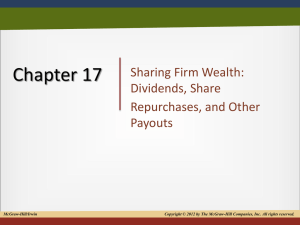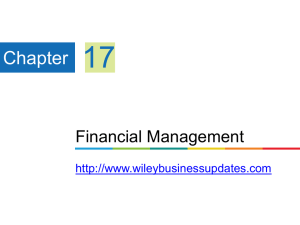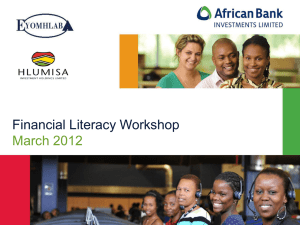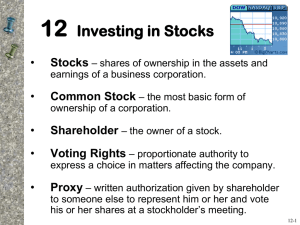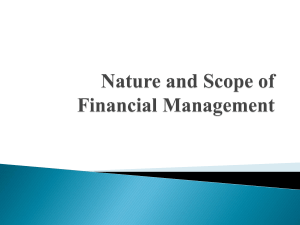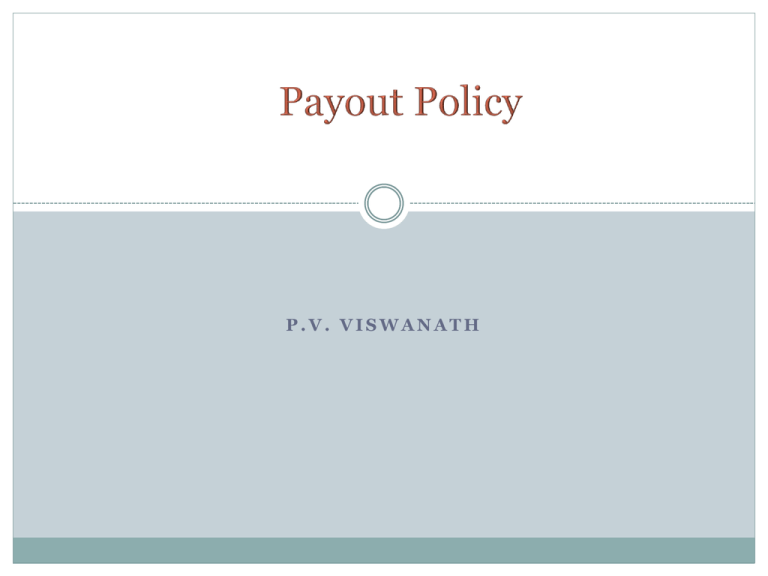
P.V. VISWANATH
2
How is cash returned? The Mechanics
How do we choose between dividends and Share
Repurchases?
Why Dividends and Share Repurchases are
irrelevant in Perfect Markets
Why dividends might be paid because of Tax
Clienteles
The choice between payout and retention of Cash
Signaling reasons for Payout Policy
3
Declaration date: The board of directors declares a
payment
Record date: The declared dividends are distributable to
shareholders of record on this date.
Payment date: The dividend checks are mailed to
shareholders of record.
Ex-dividend date: A share of stock becomes ex-dividend
on the date the seller is entitled to keep the dividend. At
this point, the stock is said to be trading ex-dividend.
P.V. Viswanath
4
There are different kinds of dividends:
Ordinary dividend: the firm pays a certain amount per share on a regular
basis – usually this amount is increased over time.
Special dividends: more than a regular dividend, but not paid all the
time. For example, Microsoft paid a $3 special dividend in 2004.
Stock dividend or stock split: this is not really a dividend at all; the
stockholder gets a certain number of additional shares per share that
s/he owns. If the number of additional shares is large such as 2 or 2.5,
it’s called a stock split.
Dividend reduce the firm’s retained earnings. In some cases,
dividends are attributed to other accounting sources, such as
paid-in capital or the liquidation of assets. In this case, the
dividend is known as a return of capital or a liquidating
dividend. A return of capital is treated as a capital gain rather
than as a dividend for the investor.
Another way that the firm can return cash to shareholders is
by buying back shares.
5
Open Market Repurchase: A firm announces it intention to buy its
own shares in the open market and then proceeds to do so over time
like any other investors; the firm is not supposed to buy back the
shares in such a way as to manipulate the price. Share repurchases
represent 95% of all repurchase transactions.
Tender offer: a firm offers to buy shares at a pre-specified price
during a short time period – generally within 20 days. The price is
usually set at a substantial premium to the current market price. If
shareholders do not tender enough shares, the firm may cancel the
offer and no buyback occurs.
Targeted repurchase: the firm buys directly from a specific
shareholder. This may occur if the shareholder wants to sell his
shares but is afraid of moving the market price – in this case, the
shareholder may be willing to sell at the market price; if the firm is
afraid of the shareholder’s intentions, it may buy back the shares at
a premium to the market price. This may occur if management feels
threatened by a shareholder who intends to takeover the firm. Such
a buyback is called greenmail.
Copyright © 2007 Pearson
Addison-Wesley. All rights reserved.
7
In properly functioning capital markets, the method
of redistributing cash to stockholders should not
matter – whether through dividends or through
share repurchase.
In both cases, the firm has less equity and less cash.
Since the amount of funds left invested in the firm
does not change, the present value of future
dividends should not change. Consequently, the
present value of shareholder wealth should be the
same, as well.
8
Buttle Wilson and Co. has $50 m. available for distribution.
Buttle has 10 m. shares outstanding. It expects to earn $2.50 a
share, and the current market value per share is $25. The firm
has unused cash that could be used to pay a cash dividend of
$5 per share, implying an ex-dividend value of $20 per share.
Alternatively, the firm could use the $50 m. to repurchase 2
m. shares ($50,000,000/$25). Following the share
repurchase, each share would be worth (10*25-50)/(10-2) =
$25.
As long as the firm repurchases the shares at the market price
of $25, a shareholder who does not sell will have the same
wealth as a shareholder who does sell--$25. The difference is
that the former has it in stock, the latter in cash.
If Buttle paid the $5 dividend, every shareholder would have
their wealth in the same form--$5 in cash plus $20 in stock.
9
Following the distribution of the $50 m. whether through a stock
repurchase or through a dividend payment, the firm's shares will trade at a
P/E ratio of 8 (= $20/$2.50).
Neither the firm's capital structure nor its capital investment policies are
affected by the method of cash distribution; hence the risk-return tradeoff
is the same.
Under the dividend alternative, the EPS is unchanged at $2.50, because the
$50 m. paid out were unused, and the number of shares is unchanged.
Each shareholder gets (EPS x P/E = $2.50 x 8 =) $20 + $5 = $25 in total
value.
Under the share repurchase alternative, the projected EPS is higher at
(2.5*10)/8 = $3.125.
However, shareholder value is (EPS x P/E =) $3.125 x 8 = $25, once again.
The higher EPS is exactly offset by the drop in the P/E ratio from ($25/2.5
=) 10 before the stock repurchase to 8 afterwards.
The confusion over the impact of share repurchases results from the
mistaken view that share repurchase will not alter the P/E ratio. But paying
out cash results in a riskier firm and hence the P/E ratio must drop (the
required rate of return must rise).
10
If markets are imperfect, there may be reasons to repurchase
shares. Some reasons are value-increasing; others valuedecreasing.
The following four reasons are value-increasing.
Tax considerations:
Gains to individual shareholders from share repurchases are taxed at the capital
gains rate, which is usually smaller than the tax rate on cash dividends. However,
a regular policy of repurchasing shares could be disallowed by the IRS for
favorable capital gains treatment.
Eliminate Small Shareholdings:
The cost of servicing a small shareholder account is roughly the same as that of
servicing a large shareholder account. Hence repurchasing shares of small
stockholders could reduce overall stockholder service costs.
Increase Leverage:
If the firm wishes to increase debt in its capital structure, it could borrow funds
and use the proceeds to repurchases shares or offer its shareholders the
opportunity to exchange their shares for a new debt issue.
11
Exploit Perceived Undervaluation:
If a firm's stock is perceived by the management to be undervalued, repurchasing
shares at a favorable price could increase the wealth of the firm's remaining
shareholders. However, if investors believe that the share repurchase is being
undertaken for this purpose, share prices will jump to reflect market belief in a
higher share value. If so, the true wealth of the firm's remaining shareholders
would not increase; however, the market value of their shareholdings will increase,
which can be valuable for shareholders who desire liquidity.
The following two reasons are value-decreasing.
Consolidation of Insider Control:
Firms sometimes purchase stock from contentious minority stockholders,
sometimes at a premium (greenmail). At other times, they may do so to reduce
public float--to reduce the percentage of stock held by persons not affiliated with
the insider group.
Protection against Takeovers
Stock repurchases may also be designed to reduce the attractiveness of the
company as an acquisition candidate, thus enhancing management's security.
These objectives may not be consistent with firm value
maximization.
12
Stellar, Inc. has decided to invest $10 m. in a new
project with a NPV of $20 m., but it has not made
an announcement.
The company has $10 m. in cash to finance the
new project.
Stellar has 10 m. shares of stock outstanding,
selling for $24 each, and no debt.
Hence, its aggregate value is $240 m. prior to the
announcement ($24 per share).
P.V. Viswanath
13
Two alternatives:
For both alternatives, we will see that the investor
ends up in the same situation, thus proving
dividend irrelevance.
One, pay no dividend and finance the project with
cash.
The value of each share rises to $26 following
the announcement. Each shareholder can sell
0.0385 (= 1/26) shares to obtain a $1 dividend,
leaving him with .9615 shares value at $25 (26
x 0.9615). Hence the shareholder has one share
worth $26, or one share worth $25 plus $1 in
cash.
P.V. Viswanath
14
Two, pay a dividend of $1 per share, sell $10m. worth of new
shares to finance the project.
After the company announces the new project and pays
the $1 dividend, each share will be worth $25.
To raise the $10 m. needed for the project, the company
must sell 400,000 (=10,000,000/25) shares.
Immediately following the share issue, Stellar will have
10,400,000 shares trading for $25 each, giving the
company an aggregate value of 25 x 10,400,000 =
$260m.
If a shareholder does not want the $1 dividend, he can
buy 0.04 shares (1/25).
Hence, the shareholder has one share worth $25 and $1
in dividends, or 1.04 shares worth $26 in total.
P.V. Viswanath
Modigliani–Miller Theorem on Dividend Irrelevance
In perfect capital markets, holding fixed the investment
policy of a firm, the firm’s choice of dividend policy is
irrelevant and does not affect the initial share price.
A firm’s free cash flow determines the level of
payouts that it can make to its investors.
In a perfect capital market, the type of payout is irrelevant.
In reality, capital markets are not perfect and it is
these imperfections that should determine the firm’s payout
policy.
17-15
Copyright © 2007 Pearson
Addison-Wesley. All rights reserved.
16
Shareholders must pay taxes on the dividends they receive and they
must also pay capital gains taxes when they sell their shares.
Dividends are typically taxed at a higher rate than capital gains. In
fact, long-term investors can defer the capital gains tax forever by not
selling.
The higher tax rate on dividends makes it undesirable for a firm to
raise funds to pay a dividend.
When dividends are taxed at a higher rate than capital gains, if a firm raises money
by issuing shares and then gives that money back to shareholders as a dividend,
shareholders are hurt because they will receive less than their initial investment
The optimal dividend policy when the dividend tax rate exceeds the
capital gain tax rate is to pay no dividends at all.
The payment of dividends has declined on average over the last 30
years while the use of repurchases has increased.
The surprising fact, though, is that firms continue to pay dividends!
17
18
Copyright © 2007 Pearson
Addison-Wesley. All rights reserved.
19
Copyright © 2007 Pearson
Addison-Wesley. All rights reserved.
20
Question: Suppose
A firm raises $25 million from shareholders and uses this cash to pay them $25
million in dividends.
Dividends are taxed at a 39% tax rate and capital gains are taxed at a 20% tax
rate.
How much will shareholders receive after taxes?
On dividends, shareholders will owe:
39% × $25 million = $9.75 million in dividend taxes.
Shareholders will lower their capital gains taxes by:
20% × $25 million = $5 million; the value of the firm will fall when the dividend
is paid lowering the shareholders’ capital gains.
Shareholders will pay a total of $4.75 million in taxes.
$9.75 − $5.00 = $4.75 million
Shareholders will receive back only $20.25 million of their $25
million investment.
$25 − $4.75 = $20.25 million
21
Many investors have a tax preference for share repurchases over
dividends. But this is not true of all shareholders!
To look at shareholder preferences, we need to quantify the combined
effects of dividend and capital gains taxes.
Consider an investor who buys a stock today just before it goes exdividend and sells the stock just after. If the stock pays a dividend of
Div, the after-tax cashflow is from the dividend is Div(1-td).
In addition, because the stock price just before the stock goes exdividend Pcum is less than the price just after, Pex, the investor will
experience a tax loss and obtain a capital loss providing an after-tax
loss of Pcum-Pex(1-tg).
Hence the investor obtains a gain by this procedure if Div(1-td) > PcumPex(1-tg). To prevent arbitrage, therefore, the two quantities should be
equal. This can be rewritten as:
t d t g
Pcum Pex Div(1
) (1 t d* )
1 t g
22
The effective dividend tax rate td* measures the additional tax
paid by the investor per dollar of after-tax capital gains
income that is instead received as a dividend.
The effective dividend tax rate for an investor depends on
many factors:
Income level – higher income investors fall into higher tax brackets.
Investment horizon – capital gains on stocks held less than a year are
taxed at higher ordinary income tax rates. Investors who bequeath the
stock to their heirs avoid capital gains taxes altogether.
Type of investor – investment in retirement accounts or by nonprofit
endowment funds are not subject to taxes. Corporations that hold stocks
exclude 70% of dividends from corporate taxes, but not capital gains.
Thus for a corporation, td* = -38% today, assuming td = 15%.
Tax jurisdiction – investors are subject to state taxes that vary across
states; e.g. New Hampshire imposes no tax on capital gains, but does
impose a 5% tax on dividends.
23
This theory says that
absent transaction costs,
investors can trade shares
at the time of the dividend
so that non-taxed
investors receive the
dividend
An implication of this
theory is that we should
see large trading volume in
a stock around the exdividend day, as high-tax
investors sell and low-tax
investors buy the stock in
anticipation of the
dividend, and then reverse
those trades just after the
ex-dividend date.
24
25
On Aug 2, 2005, CorpCo declares a dividend
payable on October 3, 2005. CorpCo announces
that shareholders of record on or before Sept 30,
2005 are entitled to the dividend. The stock goes
ex-dividend Sept 28, 2005, two days before the
record date.
Anyone who bought the stock before September
28, 2005 or after would get the dividend.
The stock price will fall after the dividend
payment, but usually less than the div amount. If
the trader is tax-neutral, selling right after the
stock goes ex-dividend, i.e. on Sept 28, can net
the trader a profit.
P.V. Viswanath
26
Modigliani-Miller Payout Irrelevance Proposition: In
perfect capital markets, if a firm invests excess cash flows
in financial securities, the firm’s choice of payout versus
retention is irrelevant and does not affect the value of the
firm.
If there are positive NPV projects, clearly the firm should
invest in them.
After making such value-increasing investments, if the
firm pays out excess cash to shareholders, the value of
the firm will not decrease.
Alternatively, if the firm retains the excess cash and
invests it in financial securities that are properly priced,
there should be no impact on firm value, since these
securities are presumably zero NPV investments.
27
Suppose Barston must pay corporate taxes at 35% on the interest it will earn from
the Treasury bills. In this case, Barston shareholders who pay taxes at a rate lower
than 35% would prefer that Barston distribute the money in cash as opposed to
retaining it and investing it in taxable securities.
28
Suppose Barston must pay corporate taxes at 35% on the interest it will
earn from the Treasury bills. In this case, Barston shareholders who are
pensioners and pay taxes at a much rate lower than 35% would prefer that
Barston distribute the money in cash as opposed to retaining it and
investing it in taxable securities.
Even shareholders who do pay taxes at higher rates would prefer that
Barston not hold on to the cash. This is because Barston has to pay
corporate taxes on the interest income. In contrast, if Barston pays out the
cash, the shareholders only pay tax at the rate levied on interest income,
which is usually around the level of the corporate tax rate or less.
Furthermore, the price of Barston stock would drop giving shareholders a
valuable tax loss.
We don’t worry about the tax that would be paid on dividends by
shareholders if Barston paid out the cash as dividends because this is a tax
that has to be paid by shareholders either now or in the future when
Barston pays out the interest on the cash as a perpetuity.
The effective tax disadvantage on retaining the cash can be computed as:
1 t c 1 t g
*
t retain 1
1 t i
29
If there is a tax disadvantage to holding cash, why do firms continue
to hold cash?
One answer is that they do so to cover future potential cash
shortfalls.
If there is a chance that the company may need money in the future
to fund positive-NPV investment opportunities, the firm may prefer
to put money aside today for that eventuality. The alternative of
paying out the money today and raising funds in the future may not
be attractive because of information asymmetry problems, which
may require the firm to issue new securities at a time when the firm
may be undervalued by investors.
In addition, the firm can save issuance costs of 1-3% for debt
issuance and 3.5% to 7% for equity issuance.
On the other hand, the free cash flow hypothesis suggests that
managers may engage in empire-building and in others investing
free cash in NPV<0 projects.
30
Firms prefer to smooth dividends even though earnings
themselves may be volatile. This may be because of
investor preferences for smooth dividend payment
streams to allow them to plan better.
As a result, managers tend to increase dividends only if
they can maintain the increase and are loth to decrease
them.
Given this, a decision by a manager to increase dividends
could contain information regarding the manager’s belief
that future cashflows will be high enough to allow the
firm to continue paying dividends at that higher level.
This works similar to signaling with debt.
31
Share repurchases differ from dividends in terms of their
potential to be used as signals:
Managers are less committed to share repurchases than to dividends;
when they announce share repurchases, they announce a maximum
amount and buy back the shares over a period of time – sometimes
they suspend or cancel the buyback.
Firms do not smooth their buyback activity – hence the information
content in deviations is less.
On the other hand, the cost of a buyback depends on the
price of the share – the lower the share price, the less the
cost of the buyback. Hence a buyback decision could
convey information directly that management believes
shares to be underpriced.
Share price go up, on average, when a firm announces a
buy-back.
32
A stock dividend does not involve any cash returned to
shareholders and stock dividends are not taxed.
Firms pay stock dividends (or split their shares) to keep
trading levels for their shares low.
If the price per share is too high, investors will have to
invest a very high amount to be able to trade in a round
lot of 100 shares; prices for odd-lots are higher.
Stock splits are often followed by dividend increases –
hence announcements of stock splits are often greeted
with higher stock prices by the market.
If the price of the share is too low, bid-ask spreads are
higher, as well.
If the price falls too low, firms engage in reverse splits to
increase the price per share.
33
A firm can also distribute shares of a subsidiary in a transaction
called a spin-off.
For example, after selling 15% of Monsanto Corporation in an
IPO in October 2000, Pharmacia Corporation announced in
July 2002 that it would spin off its remaining 85% holding in
Monsanto.
This was done as a special dividend in which each Pharmacia
shareholder got 0.170593 shares of Monsanto per Pharmacia
share.
A shareholder who held 100 shares of Pharmacia would receive
17 shares of Monsanto plus (0.0593 x 16.21 =) $0.96 in cash,
since Monsanto shares were trading at $16.21 per share.
The other alternative of selling the additional Monsanto shares
and paying a cash dividend would be more expensive since
Pharmacia shareholders would have to pay tax. With a spin-off
they could decide when to sell the Monsanto shares and pay the
lower capital gains tax.
34
Stage 1
Introduction
Funding Needs
Cash flows
generated
Dividend Policy
P.V. Viswanath
Limited by size and other infrastructure
limits
Negative as investments are made
No dividends
New Stock Issues
35
Stage 2
Rapid expansion
Funding Needs
High relative to firm value
Cash flow low relative to firm
Cash flows generated
value
Dividend Policy
No or very low dividends
P.V. Viswanath
36
Stage 3
Mature growth
Funding Needs
Moderate relative to firm value
Cash flows
generated
Cash flow increases as percentage of firm
value
Dividend Policy
Increase dividends
P.V. Viswanath
37
Stage 4
Decline
Funding Needs
Low as projects dry up
Cash flows generated
Cash flow high relative to firm value
Dividend Policy
Special dividends
Repurchase stock
P.V. Viswanath
38
Investment Opportunities: A firm with more investment
opportunities should pay a lower fraction of its earnings.
Stability of earnings: A firm with more volatile earnings
should pay, on average, a lower proportion of its earnings,
so that it will not have to cut dividends.
Alternative sources of capital: To the extent that a firm can
raise alternative capital at low cost, it can afford to pay
higher dividends. Hence, large firms tend to pay higher
dividends.
P.V. Viswanath
39
Degree of financial leverage: If a firm has high leverage, it
will probably also have covenants restricting the payment
of dividends. Furthermore, to a certain extent, dividends
and debt can be considered substitutes for the purpose of
manager discipline.
Signaling incentives: To the extent that a firm can signal
using other less costly means, for example debt, it should
pay lower dividends.
Stockholder Characteristics: If a firm's stockholders want
higher dividends, it should provide them.
P.V. Viswanath
40
Questions: How much cash is available to be paid
out as dividends?
Answer: The funds available to be paid out as
dividends are essentially equal to free cash flow to
equity (FCFE)
Keep in mind these quantities should be computed
prospectively.
P.V. Viswanath
41
Direct methods of computing the Free cash flow to
equity:
FCFE = Net Income - (Capital Expenditures - Depreciation) (Change in Noncash Working Capital) + (New Debt Issued Debt Repayments) - Preferred Dividends
FCFE = Net Income - (Capital Expenditures - Depreciation)*(1Debt Ratio) - Change in Non-cash Working Capital (1-Debt
Ratio).
Using the Statement of Cashflows: this is only
available for the past
Cash Flows from Operating Activities - (Capital expenditures) (preferred dividends) - (New Debt Issued - Debt Repayments).
P.V. Viswanath
42
How good are the projects available to the firm?
If Dividends greatly exceed FCFE, dividends should be
cut.
If the rate of return on equity is greater than the cost of
equity, the released funds should be invested in new
projects and if funds are inadequate, funding should be
sought from elsewhere.
If projects are unprofitable, investment should be
reduced.
P.V. Viswanath
43
If FCFE greatly exceed Dividends, the CFO must check
to see how funds are being invested.
If the actual rate of return (accounting rate of return)
on equity is greater than the required rate of return,
then the excess funds should be invested in new
projects. If necessary, the dividend payout ratio should
also be decreased to release funds for new projects.
If the actual rate of return is low relative to the required
rate of return, then dividends should be increased.
P.V. Viswanath
44
You are analyzing the dividend policy of Conrail and have collected
the following information from the last five years (in millions):
The average debt ratio during this period was 40% and the total
noncash working capital at the end of 1990 was $10 million.
How much could Conrail have paid in dividends during this period?
If the average return on equity during the period was 13.5% and
Conrail had a beta of 1.25, what conclusions would you draw about
Conrail’s dividend policy? The average T-bond rate during the
period was 7% and the average return on the market was 12.5%
Year Net Income Cap. Exp. Depr. Noncash WC Dividends
1991
240
314 307
35
70
1992
282
466 295
-110
80
1993
320
566 284
215
95
1994
375
490 278
175
110
1995
441
494 293
250
124
Problem 8, Chap. 22 from Damodaran, “Corporate Finance: Theory and Practice”
45
Year
1991
1992
1993
1994
1995
Net
Cap. Depr. Noncash Change in
Dividends FCFE
Income Exp.
WC
Noncash WC
240
314
307
35
25
70 220.8
282
466
295
-110
-145
80 266.4
320
566
284
215
325
95 -44.2
375
490
278
175
-40
110 271.8
441
494
293
250
75
124 275.4
Conrail could have paid, on average, yearly dividends equal to its FCFE.
Conrail is earning an average accounting return on equity of 13.5%.
The required rate of return = 0.07 + 1.25(0.125-0.07) = 13.875.
Hence Conrail’s projects have done badly on average.
It’s average dividends have been much lower than the average FCFE.
Conrail should pay more in dividends.
P.V. Viswanath




